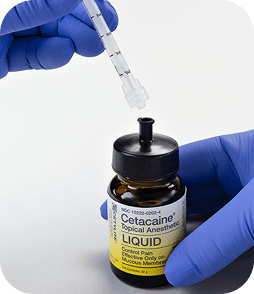There’s still time to
WIN
a year of
CETACAINE!
Click here

Comfortable patients are
happy patients
Happy patients return to a practice that prioritizes their well-being. With each application of Cetacaine, you help overcome their fear of pain and needles with up to 60 minutes of soft-tissue anesthesia… longer than typical topicals.
Skip the needle. Perform soft tissue procedures with Cetacaine Liquid and see the smiles!


Why dental hygienists
choose Cetacaine®
Cetacaine combines three anesthetic agents and is proven more effective than OTC 20% benzocaine1 topical anesthetics. Used and trusted by dental professionals for more than 50 years, Cetacaine Liquid is specially formulated for periodontal application, with a fluid viscosity that reaches into pockets with each small drop, and its anesthetic effect lasts up to 60 minutes for procedures like scaling and root planing without the injection.
Plus, each 24g bottle contains over 200 quadrant doses. Waste is minimal — you draw the amount you need. One dose lasts through treatment without stopping to add more. And with a shelf life of two years, the overall cost is lower than other topical options.

How to apply Cetacaine®
Cetacaine is easy to administer into periodontal pockets.
The dose is precisely measured and delicately applied without wasting a precious drop. A stress-free, needle-free experience for you and your patients.

Attach Luer-lock
dispensing cap
and syringe.

Invert and draw
needed amount, then
unscrew syringe and
attach pliable tip.

Apply Cetacaine
dropwise into
periodontal pockets.
Cetacaine®
There is no comparison
Unlike most topicals, like OTC benzocaine gel or lidocaine/ prilocaine products, Cetacaine has a long duration, keeping your patients comfortable for up to 60 minutes. There are no blunt metal tips or bulky applicators. The feather-light syringe and flexible, ultrafine applicator tip makes application precise, efficient and pleasant.
Find out more reasons by downloading our comparison chart.
Download Download
Download


Brief Summary of Prescribing Information
INDICATIONS: Cetacaine is a topical anesthetic indicated for use on all accessible mucous membrane where pain control is required, except the eyes.
WARNINGS/
Methemoglobinemia: Cases of methemoglobinemia have been reported in association with local anesthetic use. Do not exceed maximum dose. If a patient shows signs of methemoglobinemia, discontinue Cetacaine and any other oxidizing agents. Depending on the severity of the symptoms, patients may respond to supportive care, i.e., oxygen therapy, hydration. More severe symptoms may require treatment with methylene blue, exchange transfusion, or hyperbaric oxygen.
ADVERSE REACTIONS: Adverse reactions, such as hypersensitivity, including anaphylaxis, are rare. Discontinue use if rash or allergic reactions develop. The most common adverse reaction caused by local anesthetics is contact dermatitis. Cetacaine should not be applied for prolonged periods except under continual supervision.
PEDIATRIC/PREGNANCY/
CONTRAINDICATIONS: Do not use Cetacaine to treat infants or children younger than 2 years. Do not inject or use in the eyes. Cetacaine is contraindicated in patients who are hypersensitive to any of its ingredients or are known to have cholinesterase deficiencies. To avoid excessive absorption, Cetacaine should not be used under dentures or cotton rolls, as prolonged contact may cause an escharotic effect. Routine topical anesthetic precautions should be observed.
For complete prescribing information visit www.cetacaine.com.





 Injection-Free
Injection-Free About 200
About 200 Lasting anesthesia:
Lasting anesthesia: